 Hi – Workshop Area: the dementia participants often gravitate towards gender specific activities. Building projects (build a box), sanding, pipe fitting will help men stay active. Enjoy – Meghan (text me if you have questions 303.717.5134)
Hi – Workshop Area: the dementia participants often gravitate towards gender specific activities. Building projects (build a box), sanding, pipe fitting will help men stay active. Enjoy – Meghan (text me if you have questions 303.717.5134)
Donate Now!
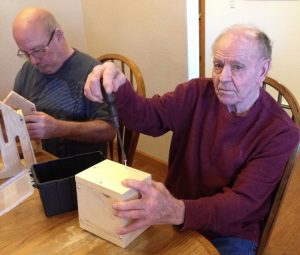
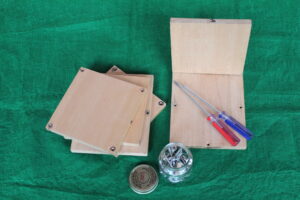
Build-a-box – Early stage: Tell the participant to help you to build a box. Provide 18 screws, either a straight-edge or Phillips-head screwdriver, and 6 wood squares. Hold the (predrilled) panels of the box at 90 degrees to each other. Let the participant screw in the predrilled holes—it might take a while, but they will have a smile when they are done. Repeat if the participant would like to do another panel.
 If the resident wants you to do the activity for them, then you have a couple of choices:
If the resident wants you to do the activity for them, then you have a couple of choices:
or you can help the resident but after one minute, say “It’s your turn!”.
DO NOT do the activity for them – that is not you goal!
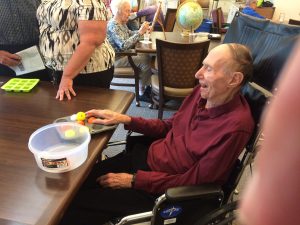
 Golfballs and a muffin tin–This activity requires 12 golf balls (white and/or colored) and a mini muffin tin or egg carton. We do not recommend this for early-stage dementia, but it is great for middle and advanced stages. Tell your participant to put the golf balls in the muffin tin or egg carton. Late stage: Put one golf ball into your participant’s hand and tell them to place the golf ball into the muffin tin. Praise them for placing it into the tin. Once the golf balls are in the tin or egg carton, tell your participant to put the golf balls back into the bowl. This activity is great for visually impaired.
Golfballs and a muffin tin–This activity requires 12 golf balls (white and/or colored) and a mini muffin tin or egg carton. We do not recommend this for early-stage dementia, but it is great for middle and advanced stages. Tell your participant to put the golf balls in the muffin tin or egg carton. Late stage: Put one golf ball into your participant’s hand and tell them to place the golf ball into the muffin tin. Praise them for placing it into the tin. Once the golf balls are in the tin or egg carton, tell your participant to put the golf balls back into the bowl. This activity is great for visually impaired.
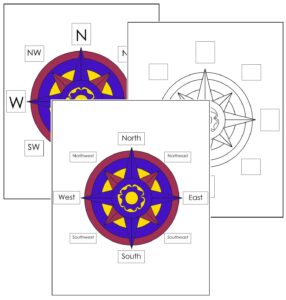 Compass Rose: compass directions – download them now
Compass Rose: compass directions – download them now
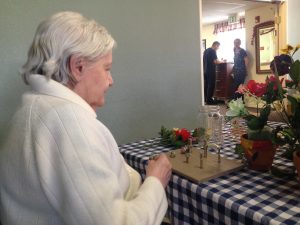
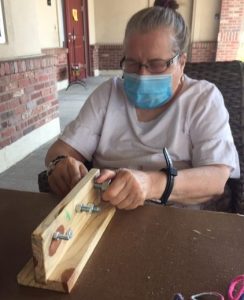 Nuts and bolts – This activity requires a wood board cut 1–1.5 ft long, <1 ft wide, and < 2 in thick and three different-sized bolts and wing nuts. Drill six holes sized to the various bolts. Early stage: Show participants how to place the bolt through the board and turn the wing nuts (turn right to tighten the wing nut and left to loosen it), and then ask them to help you. Advanced stage: Place the bolt on the board and insert the wing nut but turn only once. You may need to place the participant’s hand on the wing nut and say, “Turn the wing-nut to the right.” Show them with your hand. Or three holes in a plank and three different sizes nuts and bolts.
Nuts and bolts – This activity requires a wood board cut 1–1.5 ft long, <1 ft wide, and < 2 in thick and three different-sized bolts and wing nuts. Drill six holes sized to the various bolts. Early stage: Show participants how to place the bolt through the board and turn the wing nuts (turn right to tighten the wing nut and left to loosen it), and then ask them to help you. Advanced stage: Place the bolt on the board and insert the wing nut but turn only once. You may need to place the participant’s hand on the wing nut and say, “Turn the wing-nut to the right.” Show them with your hand. Or three holes in a plank and three different sizes nuts and bolts.
Nuts and bolt are simple enough to work well in the later stages of dementia. Lay out a container of mixed nuts and bolts, and ask your relative to help you sort them into different categories. This activity is great for visually impaired.
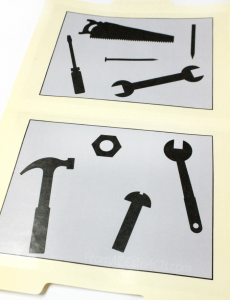
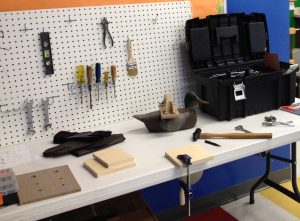
Tool matching – Early and middle stage: Provide a small toolbox and tools with their corresponding pictures or tool names.
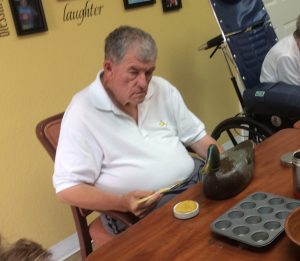

Sanding – Participants with early- to late-stage dementia can easily do sanding. You will need a piece of sandpaper and a piece of wood (e.g., a wooden duck, mini baseball bat, or wooden picture frame). The sandpaper needs to be medium grain, not too coarse or fine. When the participant is done, have him polish the piece of wood (using vegetable oil and a paintbrush).
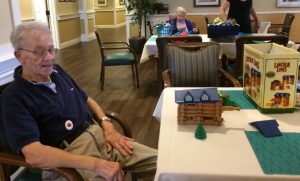
Lincoln log building – Each has indentations that can be used to connect it with others. Pieces are included for the roof, roof facade, walls, chimney, porch, and fences.
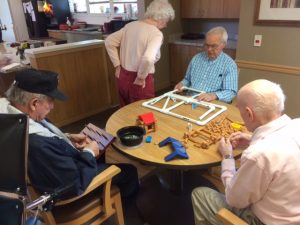
Pipe fitting – Early to late stage: In a small box, place four to six straight plastic pipe pieces (1” or smaller diameter and 6” in length) and four to six elbows and three-way connectors. Have the participant put the pieces together or ask them to help you. Encourage the participant to connect all the pieces. This activity is great for visually impaired.
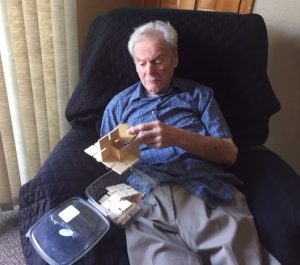
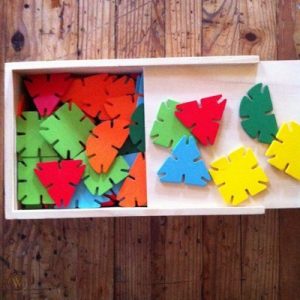
Interlocking 3-dimensional objects – You can build with cardboard or wooden cut outs for early-middle stage dementia. Also called Klickits (MindDesigns.com). These interlocking wooden tiles provide endless designs for creativity and fine motor dexterity. Connect the individual Klickits to create unlimited designs. A system built to build.

Loop and shoelace on wooden board – For middle to late state dementia, you can tie the shoelace on one of the loops and he/she can thread the shoelace through as many loops as they want. You can make it yourself: A pack of Steel Screw Eye Hooks, a board, and shoelace. This activity is great for visually impaired.
